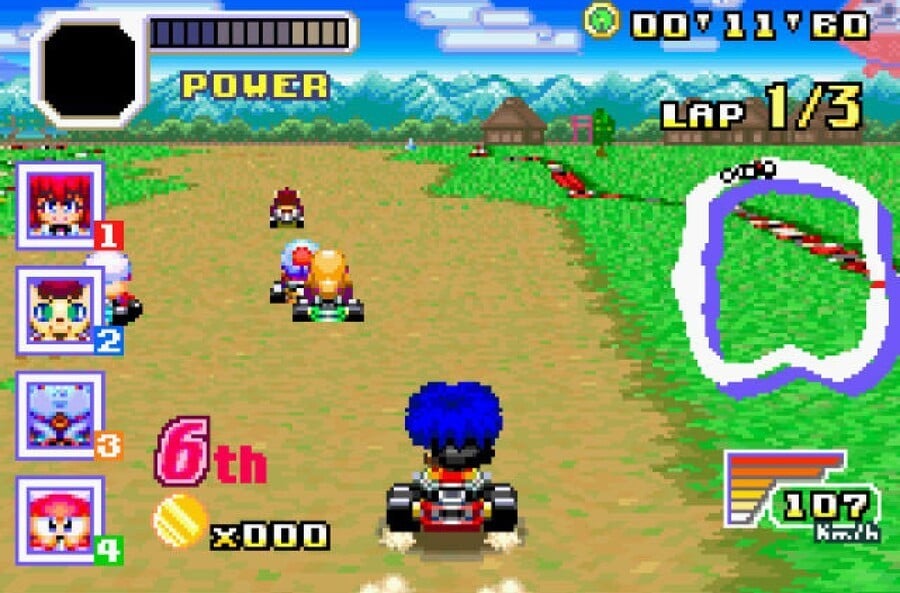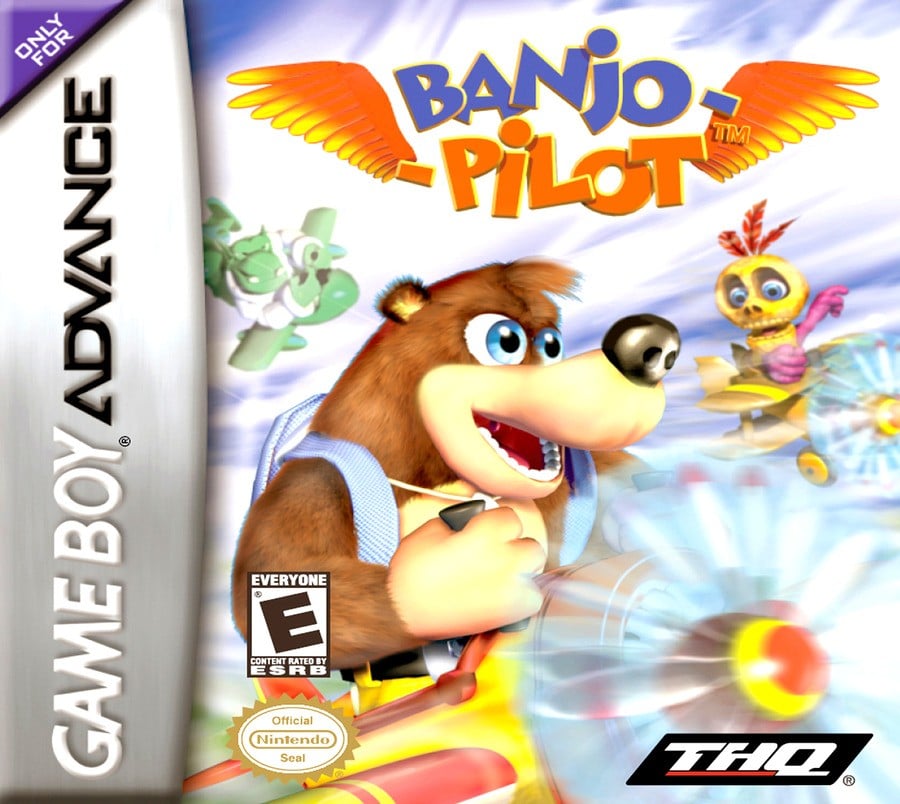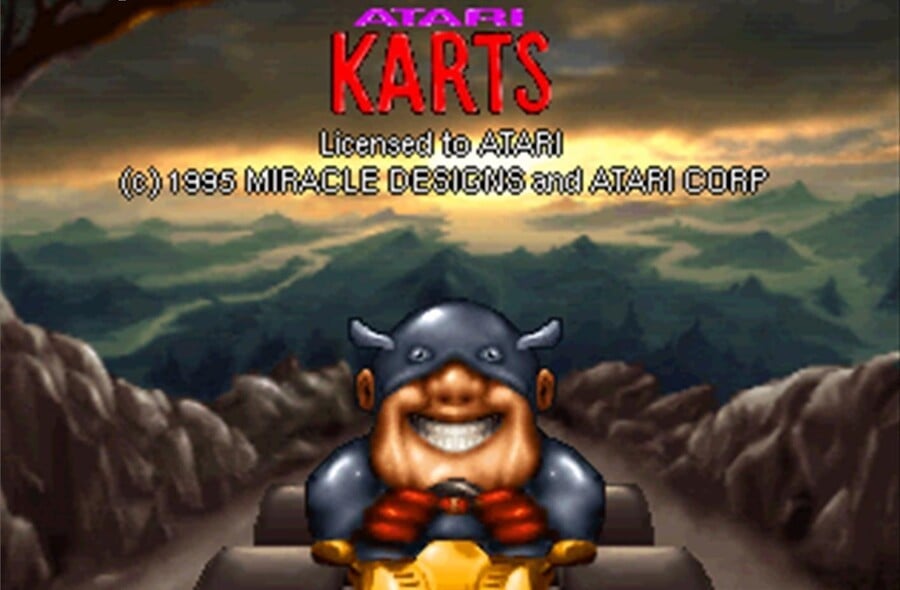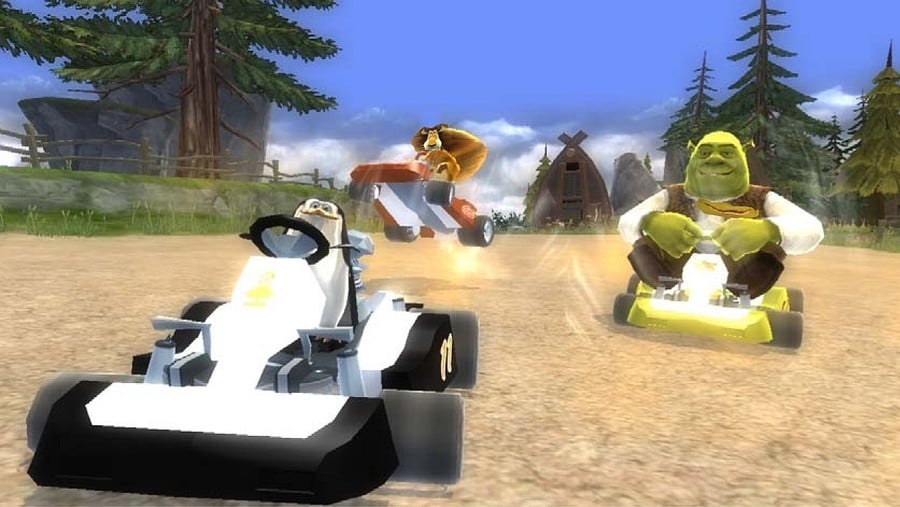Every time a Nintendo device is released, it’s a pretty safe bet that Mario Kart isn’t far around the corner. Each new addition to the series further solidifies its well-earned reputation as the party game of choice, bringing together both the masters and the first-timers to join in on the madness and enjoy it regardless of their experience level. It’s the closest thing we’re ever likely to get to world peace, as what argument can’t be sorted out on the race course with a few green shells in tow? Friends, family, strangers and enemies all uniting in the name of (not so) friendly competition is enough to get us teary-eyed, and when the original released on Super Nintendo in 1992 it created an entire genre.
They say that imitation is the sincerest form of flattery, so Mario Kart can definitely claim to have more than a few admirers. There have been plenty of imitators over the years, as developers attempted to capitalise on the sudden interest in Kart racers. Defined by their simple gameplay and imaginative tracks, these titles ranged from the generic to the grand with more examples than we could ever hope to fully collate here. With that in mind, park up and enjoy a small selection of games inspired by Nintendo’s racer, and the genre that kick-started a thousand tiny engines.
Subscribe to Nintendo Life on YouTube841k

Konami Krazy Racers
Just one ‘K’ away from being a bad decision, Konami made the wise choice here to change ‘Kart’ to ‘racer’ and enter into the fray on GBA.
First released in 2001 as a launch game for Nintendo’s handheld, it features nearly all the same characteristics that define Mario Kart and actually managed to slip out several months before Super Circuit did. It follows the formula to a tee and manages to make it work very well indeed, utilising Mode 7 to simulate three-dimensional environments and even allowing for that pre-race boost if the player accelerates correctly during the countdown. Offensive and defensive items were found in bells placed at pre-determined points along the track, and coins collected along the way could be spent in a shop for multi-use variants.
There are a total of 12 characters from a variety of popular Konami franchises including the Metal Gear and Castlevania series, represented by cyborg ninja Grey Fox and lord of darkness / karting enthusiast Count Dracula himself. A sequel for iOS and Android devices released in 2009 added horrors from Silent Hill to the mix — psychological monstrosities evidently make for good drivers. With innovative single player challenges and tight controls, this one is well worth a look for retro karting fans.

Banjo Pilot
Diddy Kong Racing needs no introduction. It’s remembered fondly by many, treasured by some, and we won’t even begin to get into competitive debate on it here. Instead, let’s shine a spotlight on the game that was almost its sequel.
Originally developed as Diddy Kong pilot by third-party giant Rare, Microsoft’s purchase of the company forced a total makeover and cast-change before it could release. Characters switched from the Nintendo-owned Donkey Kong and Mario series to Rare’s Banjo Kazooie series instead, meaning that the bear and the bird took to the skies as Diddy waited it out. The end result finally released early in 2005 for GBA, featuring nine playable characters and some fun multiplayer modes such as dog-fight and head-to-head.
Banjo Pilot is notable not only for it’s distinctive aerial racing, but for its historic place as the last Banjo-Kazooie game released for a Nintendo console. Bananas, KONG letters and tilt-sensor controls were all lost during the transformation - hinting at the game that almost was - but Banjo fans can proudly claim to have a more than competent racer all of their own. Though it was criticised for a lack of story and simple design, it’s still a fun little anomaly in its own right.

Atari Karts
Not even the ill-fated Atari Jaguar could resist challenging Mario Kart with a competitor of its own. Thus, the obscure clone Atari Karts was born.
As an imitator, it succeeds in creating a very similar experience to the original Super Mario Kart but does little to make itself stand out as a real alternative. Environments such as the moon and a palace landscape can look nice, but it’s clear that there just isn’t enough workable material here to make anything recognisable. For example — playable characters range from minor guest stars such as Bentley Bear from arcade title Crystal Castles to the utterly unknown Skully, Miz Tress and Miracle Man. Atari buffs will recognise some neat references in cup names, but that’s about it.
All that aside it’s a functional clone, albeit one that came three years later, and can amuse for a few laps at least. There’s only one mode - a standard grand prix with three cups and four difficulty levels to choose from – and this isn’t helped by the fact that computer AI practically maps rivals onto set paths without deviation, such is their ridiculously perfect driving style. Other racers won’t even use items, which grant speed boosts, improve your handling and provide other passive effects. The only offensive item reverses your opponent’s directional buttons, which is effective when playing splitscreen at least but in single player it sucks a lot of the fun out of proceedings. We can’t help but wonder why Atari didn’t include more well-known characters to help boost interest, but perhaps it simply wanted to quickly fill a four-wheeled void in its line-up.

DreamWorks Super Star Kartz
As time went on, boundaries only grew when it came to kart racers. Once a certain bandicoot proved his worth for Sony with a winning title of his own, it seemed more likely than ever that someone could toss their characters into buggies and come up with a smash hit. Enter DreamWorks.
Super Star Kartz — wearing a ‘z’ so aggressively cool that it might as well have worn shades — was by no means the studio's first attempt to create a Mario Kart-beater, but it does represent the first amalgamation of its franchises on the racetrack. By the time it released on Wii in 2011 most of the playable characters had already released multiplatform racing games of their own, even Antz having been represented on Game Boy Color. (Everyone loved Antz, right?) Pulling a roster from some of its most successful movies, DreamWorks' sole innovation is that each racer came with their own special ability a lá Double Dash, such as penguin captain Skipper’s ability to yell into a megaphone.
It serves as a mediocre example of the Mario Kart formula being applied to almost anything, as television networks, cartoons and film tie-ins alike released further additions to the genre decades after it was first pioneered. It’s not at all broken, works fine for younger players and has enough familiar faces to get by, but the core experience is wholly unremarkable. If there’s one thing Mario Kart seems to get right every time, it’s making sure that the fun, active gameplay justifies the charming aesthetic, not the other way around. As a casual, family afternoon it’s sure to provide entertainment courtesy of the lovely Shrek or the Madagascar crew, but like its contemporaries it never strives to be much more than that.

Sonic & All Stars Racing / Transformed
Not everyone is entirely without inspiration however, and when SEGA pooled its collective resources and canon together into a racing game of its own it eventually managed to release something that made Sonic R feel like it was just a bad dream — developer Sumo Digital is due a lot of credit.
Sonic & SEGA All Stars Racing was a major step in the right direction, but it didn’t quite emerge from the obvious shadow cast by the titan that was Mario Kart Wii. With such a loyal fan base and a wealth of material to draw from, it was only a matter of time before SEGA truly rose above emulating its rivals and set out to make a real contender of its own. Sonic & All Stars Racing Transformed was that contender. Launching with Wii U at the end of November, it added the ability to transform each vehicle into both plane and boat form to add some welcome variety to gameplay and the tracks themselves. There was a tangible change to control in each transformation, and navigating each ever-changing environment felt equal parts familiar and spectacular thanks to some impressive visuals.
As always the mascots were brought out in full force as well, with the addition of Mii-usage on the Wii U and surprise entrants outside of the SEGA family such as Wreck-It Ralph and, err…NASCAR driver Danica Patrick. It’s a real treat to see so many entrants represented by unique vehicles and transformations, as well as some neat minigames to make use of the GamePad. Something that seems like even more of a defining feature now is the ability to play with 5-player splitscreen using the GamePad as an actual screen, not just a horn. With Mario Kart 8 upon us the Wii U can once again claim it’s karting legend, but for a long time All Stars Racing Transformed was the best choice and fit the task exceptionally well – a reminder to Nintendo not to rest too much on its laurels, which it thankfully responded to with a gleeful gravity-boost.
Want to know more about how Mario Kart has influenced other kart and racing games? Then check out our substantial interview feature with the developers that tried to beat Nintendo at its own game.





Comments 59
konami krazy racers is my favorite gba racer. sorry super circuit but you'll have to settle for second in my heart.
I enjoyed playing Sonic and Sega's All-Star Racing when I rented it for the 360. It is a superb alternative for those who don't own a Nintendo console and are wanting their karting fix.
Sonic and All Stars Racing Transformed has got to be one of the best alternatives to Mario Kart I've ever played. It was like the Mario Kart 7.5 of it's time. XD
Diddly kong racing what a fantastic game remember the days when Rare were making games of that quality such a shame to see the state off them now
I actually have Banjo-Pilot! I bought it when I was too young to know what Mario Kart was, so I loved it! Actually, I didn't know what Banjo-Kazooie was either. Oh well.
All stars racing transformed is better than Mario kart 8.Driving on walls and ceilings is not as interesting as flying a plane and piloting a boat.Also Crash Bandicoot did anti-gravity before Mario so it isn't something new,unlike ASRT.
nothing about Crash Team Racing?
seems a little strange to leave it out
OT: out of all the games mentioned Sonic and All Stars Racing Transformed was my fav it's a solid fun kart racer
nothing about Crash Team Racing?
seems a little strange to leave it out
OT: out of all the games mentioned Sonic and All Stars Racing Transformed was my fav it's a solid fun kart racer
The thing that gets me is how Sonic Racing Transformed really managed to one-up Mario Kart in quite a few ways. Sure, it has less tracks, but the tracks themselves are more interesting with their constant changing and boat/air parts that actually matter. And of course, the single player had the same GPs and Time Trials that Mario does...but it also had the lengthy mission mode and a huge collection of achievements. I'm enjoying MK8, but if Sumo puts out another Sonic Racing without all the bugs and a better online then Mario will be left eating its dust.
Wacky Wheels was the first Mario Kart clone I was exposed to and it was on the PC.
@FullbringIchigo: https://www.nintendolife.com/news/2014/05/mario_kart_month_the_developers_who_tried_to_beat_nintendo_at_its_own_game
They talk about it in that article.
Sonic all-stars Racing Transformed was good. as was Crash Team Racing
oh and you forgot this game and this game
and this game 
The thing about Sonic Racing games I don't understand is why does Sonic participate riding a vehicle. . He runs faster than it! Small gripe I have with it lol don't judge me.
@BLPs When exactly? I don't remember Crash Team Racing had a wall thing.
I know @BLPs but ugh I'm so used to him running and not being able to sit still lol.
@Kaeobais oh I missed that onr, cheers
@Porky the instruction book for the first game said he was useing the car to make it fair to the other drivers as on foot he was to fast to beat
Mario Kart is so fun, even Jesus gets in on the action!

@FullbringIchigo I see XD. By the way, your name is.. revealing o.O. I am only far into Bleach when it's on Toonami once a week and last nights episode mentioned Fullbring. So i suppose Ichigo and Chad develop Fullbring.
Some very good Mario Kart clones:
Some not-so good Mario Kart clones:
@BLPs oh wait Crash Nitro Kart.. oh wait that was one of those mediocre crash games that was made after the PS1 era. no wonder i forgot about that game.
@Porky if you don't mind me giving some spoilers I will
@retro_player_22 I liked Mickey Speedway USA and the first Lego Racer, plus Donkey Kong Racing didn't even have gameplay videos, so how would you know if it was good
Don't forget about Street Racer, a very enjoyable kart game on SNES that's actually on a par with Super Mario Kart except for the character roster.
As some other commenters, I'm missing the Crash Bandicoot racing games on this list too, especially as they appeared on the GameCube and as the pretty great Crash Tag Team Racing was pretty much the closest thing to Diddy Kong Racing ever released.
Extending the meaning of MK clones a bit: Snowboard Kids!!
With Konami being a reliable supporter of the Virtual Console (and the iOS release showing that the series isnt entirely forgotten), I hope that Konami Krazy Racers will make it on the WiiU GBA VC! Maybe already before MK Super Circuit – again.
I tried playing All-Stars Racing Transformed. I had fun in the single-player mode, but it was a nightmare to set up a quick multi-player match... Nintendo's better interface designs win by far.
And yet Mariokart is the best.
I ploughed absolutely hours into Street Racer on the SNES, with my brother. Loved the fact all the racers had their own specials.
@retro_player_22
Cel Damage is not a Mario Kart clone... it's not really a racing game.
I haven't played the other racers on this list, but the 2 Sonic racers are superb, especially Transformed. In some ways, I think it's a superior game to Mario Kart 8. Longer courses than MK 8 and they dynamically change as well and of course the ability to change into a boat or aircraft. The gameplay also seems even more intense and fast than even MK 8's 150cc mode. Anyone who likes Kart racers and doesn't yet have it most definitely should pick up a copy for their Wii U. Heck, get the first game too! Neither one costs much money these days!
None of this is to take away from MK 8, which is an awesome game. It's just that Sumo did nearly everything right with Transformed. They truly put a lot of love and time into it. I hope they make a 3rd one!
@Porky Obviously sonic uses a vehicle because he can't swim ^_^
Oh BTW, Activison actually made another kart racer for Wii/DS/PS3/360 prior to Super Star Kartz. It's called Madagascar Kartz and looks to be pretty similar to Super Star Kartz.
Obviously the next step for Nintendo beyond Mario Kart 8 and Smash Bros. regarding the Wii U is which franchise to offer to further extend multiplayer offerings. All the criticisms of it aside, the Wii U Gamepad is PERFECTLY designed for a potential multiplayer-equipped Advance Wars or Fire Emblem installment, and third parties like SystemSoft Alpha's Daisenryaku military strategy series would likewise enable players to use the Gamepad to make their moves where no one else can see what they're doing; just the results on the main TV screen.
The Wii U CAN have an incredible amount of life and lots of amazing games left in it, provided Nintendo and third parties cater to its strengths (which are more than the media typically gives it credit for).
best alternative to mario kart is crash team racing.
Cough Lego Racers Cough
I really like Banjo-Pilot. I managed to snag it right before gamestop was trying to get rid of all of thier gba games when they were selling them cheap. It gets pretty diffucult. I've still never been able to beat the Jinjo cup.
Don't forget Need for Speed Nitro: great gameplay and style, but hindered by lack of variety.

I had Banjo Pilot once, but I was disappointed by it because... I thought it would be a realistic flight-sim. No joke. I was little and desperate for one since my copy of Flight Simulator 98 (Or was it 95?) got thrown away.
Sonic R wasn't a nightmare! I actually have find memories of playing it on the PC version. It was really different than other racing games. I should try playing again.
Another good kart racer is Lego Racers. Good tracks, a unique item system, and the customization was great!
Never heard of Dreamworks Starz Kartz but I did buy Madagascar Kartz for $2.48 or something at Target. Best part about it was the included green racing wheel - exactly the same one as currenlty being promoted for the Wii U. Only it was green. So now we have 2 wheels.
I had Street Racer for PS1 back in the day. It was fun, but not as much as Mario Kart.
@AJ_Lethal Still have that one, I always wondered why no one else seems to know this game. It's a really fun racing game, with original (working!) motion controls, and a VERY arcadey feel! After getting the hang of the drifting, it became probably the best drifting I've ever experienced in a racing game.
@DiscoDriver43
Beat me to it. I LOVED Looney Toons Space Race. For me, it was always second to Mario Kart, until Sonic All Stars came out a decade or so later, then that pushed Looney Toons into 3rd place with Sonic in 2nd. Mario Kart has always been in 1st for me
The Steam version of All Stars Racing Transformed is better than Mario Kart 8 in every way possible. It took me about 100 hrs to unlock Ages's console mod and I was never bored the whole time. I have played Mario Kart 8 for less than 5 hrs and not really liked any of it so far. The characters are nowhere near different enough and there is nowhere near enough variety.
Though reviews state it's an awful game, Sonic R on the Sega Saturn and Sonic Drift 2 on the Sega Game Gear are titles I'd recommend. They're considered to be a 6/10 title, though I had a lot of fun playing those two titles in the Sonic Gem Collection compilation.
Sonic and Sega All Stars Racing Transformed was pretty cool. Haven't played any of the others but I'm sure Mario Kart is better by a longshot.
Diddy Kong Pilot actually has an early ROM build floating around the internet that got leaked by a former RARE employee or something. It's actually a near complete build and a pretty decent game for the GBA's standards. Shame it didn't get released. I've never played Banjo Pilot (or any Banjo game...) but I can imagine it must've been pretty good. Never heard of any of these other racers listed besides Sonic & All-stars Racing (which I own and love both of- fantastic games )
Wacky Races (Dreamcast) - I prefer to anything around its time.
I like Konami Krazy Racers
And
Wacky Wheels (Apogee) - using a serial cable and not being able to see your opponents screen was good.
The undisputed king is All Stars Racing Transformed though. (No way I would put 100 hours into anything if I didn't love every second of it).
@JQuest nice Jesus is playing fair
@retro_player_22 Mickey's Raceway USA wasn't bad. I'd add Beetle Adventure Racing. That was my favorite racer on the N64.
@JQuest "Nintendo presented Jesus with a new copy of Mario Kart 8. He saw that it was good." It's in the Bible. Somewhere.
I had a great time with wacky races & LT Space race on dcast and a few others ...Mk8 is the best but did MK8 really take 2-3 years to make?? just wondering...
@unrandomsam Not to mention that the tracks were more complex in Sonic Transformed too. I spent 200 hours and still was not entirely familiar with the Burning Depth and House of the Dead tracks. For MK8 I am sure I can master them in 20 hours.
Sonic All-Stars Racing (Wii-U) and Diddy Kong Racing (N64 or DS) are worth playing IMO. Not sure about the others but there are some aweful Kart racers out there. I also need to pick up Crash Bandicoot (PS1) sometime, as it sounded good in the other article.
@Superstick
Agreed. Sonic Racing Transformed is now my 2nd favorite cart racer of all time, only ranking in behind Mario Kart 8 (which is EXCEPTIONAL, btw). I'm glad Sega has a good racer now, because it means double the dose of cart racing each generation, AND we all know competition drives innovation and expansion. Nintendo and Sega will continue to try and "one-up" the other, resulting in even better games for us.
both crash team racing games were really good-my favorite was the first
Ah, Banjo Pilot. I should have serched for more information about that game before I bought it used. I had seen a review of it in NGC magazine which used OLD screenshots from the game when it still looked like THIS:
https://www.youtube.com/watch?v=ZM3uosHbQ6k
And not like this:
https://www.youtube.com/watch?v=aG_OabpUzjM
Sonic and All Stars Racing Transformed, better than Mario Kart 8.
Banjo Pilot was really fun.
What do you mean the first S&SASR didn't emerge from MK Wii's shadow?! It has excellent core gameplay, good graphics and music selections, good online play, a diverse and nostalgic character roster that shows a lot more individually among different racers (including the All-Star moves), an achievement system, a mission mode, and a Battle Mode that doesn't completely suck (not just that, it's really good).
True, MK Wii's online play was a lot more popular and therefore much easier to find a race, and I really dislike those Monkeyball courses, but now that online play has been shut down for both titles, I have to say All-Star Racing is now clearly the superior game.
Konami Krazy Racers is oft-forgotten, but was a surprisingly solid package back then. It benefited from the fact that it was a launch title, unlike MK: Super Circuit, which launched several months later. While it lacks the sheer amount of tracks SC has, it does have several unlockable characters. That is a feature which had not yet been adopted by the Mario Kart series in those days. Finding all four of those hidden characters was actually a huge challenge if you didn't want to rely on GameFaqs.com or similar sites. I remember finding this game for a low price several years after its release. Sure had loads of fun playing this game on my trusty GBA SP in the summer sun. The funny thing is that I never played MK:SC until the DS had been out for years.
Show Comments
Leave A Comment
Hold on there, you need to login to post a comment...